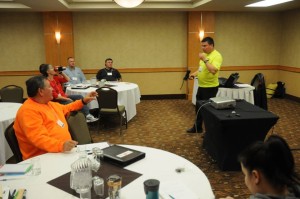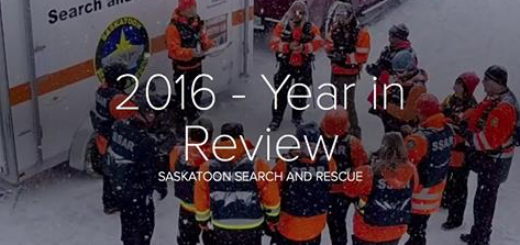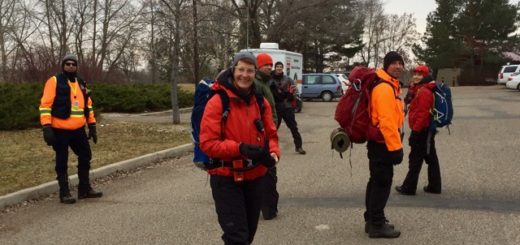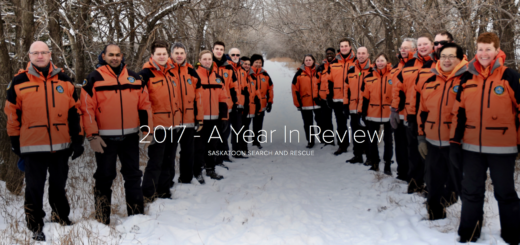Reflections on SARVAC Workshop – Saskatoon
by Dale Liebrecht
This past weekend I attended the National SARVAC Workshop in Saskatoon. As a new Saskatoon Search and Rescue (SSAR) recruit, I wasn’t sure what to expect. The weekend was filled with many engaging opportunities to meet with other volunteer SAR professionals across Canada. I experienced many moments of profound admiration for the organization as the conference evolved.

The SSAR contingent at the SARVAC workshop. L-R back row: Sean Taylor, Rebecca Basset, Lavonne Cloke, Sherry Buller, Mark Wells; Middle row: Aaron Anton, Don Brophy, Jaime Storch, Louis Bossaer, Kevin Blezy, Kent Orosz, Dale Liebrecht, Diane VanBrabant. Front row: Rick Barsky, Henry Eng, Shawn Bursey, Dale Johnstone. Missing from photo: Paul Nutter, Scott Wright, Tracy VanBrabant.
One of the images etched into my mind was the quiet confident glow of our longtime outgoing National SARVAC president Harry Blackmore. I regret not sitting down and having a conversation with him. His demeanor was reminiscent of a man that has successfully navigated several layers of local, provincial and federal government with unwavering persistence. His leadership has positioned our organization with a sustainable level of support which will serve Canadian citizens far into the foreseeable future.
SSAR member Scott Wright is now the new president. Scott had many opportunities to speak as he was one of the key people driving the workshop to a successful conclusion. Although I had very limited exposure to him, it was easy to see that he is a friendly, knowledgeable person with the natural ability to lead. He created a comfortable environment for all of us to mix and share ideas.
I spent a significant amount of time getting to know the Saskatoon Search and Rescue contingent. I learned some valuable lessons. First, I was issued my first orange SSAR shirt. I couldn’t wait to get home and try it on. It turns out that a medium looks like someone shrink-wrapped the material onto my upper body. Not pleasant! Especially when I looked in the mirror. No emergency here — I simply texted Rebecca and she solved the problem. Let’s just say that Sean will be at the next event in a material way.
One of the workshops I attended, Project Lifesaver, had a device that could locate a person with the help of a small transmitter worn by an individual. It was a little bigger than a watch. We simulated a search by sending out a member with a 10-minute head start outside the building. Using a hand-held Yagi antenna which looked like a radar gun, we proceeded to determine a bearing by listening to the strength of successive tones. The unit works very well. Randy Antonio, the Winnipeg SAR member who did the demonstration indicated that they have successfully used the system in many places. This might be something to consider as our organization evolves. I think funding may be a challenge for many of these pieces of valuable technology.
The hypothermia demonstration was very interesting. The presenter from Ontario was working with information provided by a hypothermia researcher from Manitoba. One of the many takeaways was to protect the insulated materials that are layered onto the subject with plastic to ensure they don’t get soaked. These items lose their heat containing properties when wet! We also identified the phases a person will go through when in a cold water scenario. So many details were shared and hopefully will stay retained.
An RF engineer did the presentation on radios. A very thorough run through of radio technology. The presenter mentioned that he is a member of CASARA (Civil Air Search and Rescue). Interesting. I will have to find some time to do some reading and look them up. About the only thing I know about them is that they fly around in airplanes and search from above. I am sure there are many more details I will learn over the next year.
AdventureSmart … hmmmm … whats that? I attended a session describing this very important program. The idea behind it is to attempt to give kids the tools to survive being lost in an unfamiliar environment. The most important ingredient hammers home the message of prevention. (How to not get lost in the first place!) A brilliant dramatic re-enactment was shown to demonstrate how kids can be empowered to be a part of their own rescue.
The clue awareness session was very entertaining yet educational at the same time. We were shown a video of people passing around a basketball and were asked to count how many times this had been done. I became hyper focused on following the ball. Unfortunately, this completely eliminated my peripheral vision. Ugh! We were all asked if we saw the giant gorilla. Yes, it turns out that, in the middle of this short video, a large man in a gorilla suit walked slowly through the middle of the frame. Lesson learned! You can look for something specific, but don’t let that bias impede your ability to locate other clues. Keep your periphery intact!! We also watched a “Who Dunnit” video. This one made me laugh. It was informative!
Unfortunately, I didn’t get to see the lecture from Environment Canada. I stood in the hall for a while after one of my other sessions for about the last 15 minutes. It looked very well presented and would be advantageous to gain this knowledge.
I attended ICS (Incident Command System) training and we got a little more than we asked for. We covered all of the material and then some! We had a practical conversation about how ICS plays out in the real world. The speaker was open to discuss the challenge of getting many different organizations to work together. A firefighter was present at this session who helped fight the northern fires last summer. A discussion ensued that debated the finer points of ICS. I am taking ICS 100 and 200 soon and I felt this session has given me a solid foundation.
One of the strange things I admire about the SAR group is their unusual predictability. It’s Saturday night, we just had an amazing meal, everyone has a full stomach and is a bit sleepy. Shall we go home and fall asleep in front of our favorite TV show? Nope! How about a hike in the pitch black wilderness to attempt to understand the better aspects of using a FLIR during a night mission. My kind of people!
On a solemn note, there was a point after supper that they played a video of Search and Rescue volunteer professionals that have lost their lives while training or on a mission. It was a very emotional video.
I know that I have only shared a small part of a jam-packed weekend. It was a pleasure to spend it with so many outstanding people from across the country.



